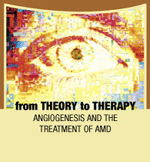Article
From theory to therapy: angiogenesis and the treatment of AMD
The recent availability of anti-VEGF agents to treat age-related macular degeneration (AMD) offers the tantalizing promise of maintaining or even improving vision, but as many questions as answers surround these new drugs.

The recent availability of anti-VEGF agents to treat age-related macular degeneration (AMD) offers the tantalizing promise of maintaining or even improving vision, but as many questions as answers surround these new drugs.
"We're struggling with the complexity of new treatments. How do we use these agents rationally?" asked Scott W. Cousins, MD, who was program chairman and moderator of a continuing medical education symposium for retina specialists held at the Wynn Hotel.
Local and systemic safety of these agents, particularly with long-term use, are critical concerns, as is the extension of the anti-VEGF drugs into new indications, such as the treatment of diabetic retinopathy, added Dr. Cousins, who is the Robert Machemer, MD, professor of ophthalmology and director, Duke Center for Macular Diseases, Duke University Eye Center, Durham, NC.
Angiogenesis is an extremely complex process, and while ophthalmologists target angiogenesis in AMD with anti-VEGF therapies, neovascularization may benefit patients with atherosclerosis and sever myocardial or peripheral ischemia, said William J. Bommer, MD, professor of clinical internal medicine, division of cardiovascular medicine, University of California, Davis.
Since individuals with AMD are typically in the same age range as those at risk for cardiovascular conditions, many questions remain. It is unclear whether AMD is associated with an increased or decreased risk of atherosclerosis or whether AMD treatment increases or decreases cardiovascular risk, Dr. Bommer said. Some trials of angiogenesis-blocking agents are powered to answer these questions, while others are not.
Until more information is available, he recommends that patients with these conditions avoid VEGF blockers. For patients at a high risk of cardiovascular events, the risk/benefit ratio should be explained before treatment decisions are made, and if the risk is low, it should be safe for patients to use these anti-VEGF agents as long as they are closely monitored.
Ranibizumab (Lucentis, Genentech) represents a paradigm shift in treatment of AMD, since studies show that sustained vision improvement is possible, said Karl G. Csaky, MD, of the National Eye Institute, Bethesda, MD.
However, one of the challenges is to identify patients who need continuous therapy versus those who might be able to be dosed PRN or less. Scheduled monthly injections appear to be the only way known at this time to sustain vision gain, since vision improvement dwindles with quarterly injections, Dr. Csaky said.
Other questions about ranibizumab therapy that have yet to be addressed include possible local and systemic toxicity, why only 30% to 40% of patients improve vision despite a 90% anatomic response, the significant treatment burden on patients and physicians, and the cost.
The role of OCT is also unclear, since OCT improvements have not always correlated with vision improvements in trials of ranibizumab, as would have been expected, Dr. Csaky said. It is possible that some of the mechanisms by which neovascularization and VEGF cause vision loss are not discernable with OCT, he added.
As intravitreal VEGF inhibitors move from clinical trials to the practice setting, long-term patient management is becoming a priority, said Mark S. Hughes, MD, FACS. Dr. Hughes is adjunct clinical assistant scientist at Schepens Eye Research Institute and a clinical instructor at Harvard Medical School, Boston.
Systemic exposure to VEGF agents is one concern. The serum half-life for injected ranibizumab is
There are also potentially increased risks for vascular and cardiovascular events.
"We have to watch very carefully for a safety signal," Dr. Hughes said.
He also suggested that there is a role for treatment of AMD with more than one agent, whether combinations of anti-VEGF agents or use of a VEGF blocker with photodynamic therapy.
"Anti-VEGF agents are an important part but not the cure. We know that the majority of these lesions continue to leak even after one year. We also know that some patients likely don't need treatment every 4 to 6 weeks; we're simply not smart enough to figure out who they are today. Also, the combination treatments are indeed evolving," Dr. Hughes said.
In another presentation, Victor H. Gonzalez, MD, director of the Valley Retina Institute and adjunct clinical instructor, University of Texas, McAllen, described research on treatment of proliferative diabetic retinopathy (PDR) with pegaptanib.
In his practice, he conducted an exploratory prospective study involving 10 patients with high-risk PDR; all were eligible for panretinal photocoagulation. All subjects were to receive 0.3 mg of pegaptanib at week 0 and every 6 weeks.
"Because of the ethical concerns of withholding a proven treatment, the FDA required us to bring the patients back at week 3 for evaluation. If 50% of the lesions from baseline had not regressed by week 3, we were to provide for panretinal laser photocoagulation," Dr. Gonzalez said.
"We were very surprised at week 3 to find that 90% of the patients had almost complete resolution of the neovascularization and 100% of them had improvement over 50% of the lesions from baseline," he continued.
Disease severity according to the ETDRS scale improved for the patients in this phase II study as well, and the mean vision of all patients either stabilized or improved. There were no significant adverse events.
A phase III trial may yield more information on which patients will respond to treatment and how best to administer therapy, Dr. Gonzalez said.
While these results are important, it must be remembered that treatment of PDR requires good systemic control, which can often be provided through laser photocoagulation.
"But we need to continue to find other therapies, and perhaps the antiangiogenics may help us manage these patients," he concluded.
The program was jointly sponsored by the New York Eye and Ear Infirmary, which received a financial benefit from (OSI) Eyetech Pharmaceuticals and Pfizer Ophthalmics, and CME2, an independent subsidiary of Advanstar Communications, publisher of Ophthalmology Times.
Newsletter
Don’t miss out—get Ophthalmology Times updates on the latest clinical advancements and expert interviews, straight to your inbox.




